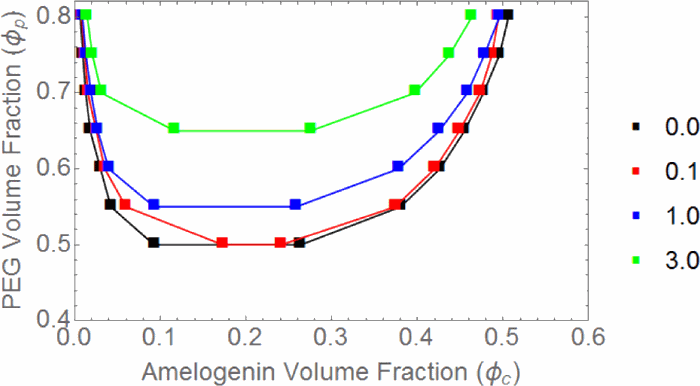当前位置:
X-MOL 学术
›
J. Chem. Phys.
›
论文详情
Our official English website, www.x-mol.net, welcomes your
feedback! (Note: you will need to create a separate account there.)
Phase diagram of a model of the protein amelogenin
The Journal of Chemical Physics ( IF 3.1 ) Pub Date : 2016-08-30 13:08:58 , DOI: 10.1063/1.4961597 Jason Haaga 1 , Elizabeth Pemberton 2 , J. D. Gunton 1 , J. M. Rickman 3
The Journal of Chemical Physics ( IF 3.1 ) Pub Date : 2016-08-30 13:08:58 , DOI: 10.1063/1.4961597 Jason Haaga 1 , Elizabeth Pemberton 2 , J. D. Gunton 1 , J. M. Rickman 3
Affiliation

|
There has been considerable recent interest in the self-assembly and phase behavior of models of colloidal and protein particles with anisotropic interactions. One example of particular interest is amelogenin, an important protein involved in the formation of dental enamel. Amelogenin is primarily hydrophobic with a 25-residue charged C-terminus tail. This protein undergoes a hierarchical assembly process that is crucial to mineral deposition, and experimental work has demonstrated that the deletion of the C-terminus tail prevents this self-assembly. A simplified model of amelogenin has been proposed in which the protein is treated as a hydrophobic sphere, interacting via the Asakura-Oosawa (AO) potential, with a tethered point charge on its surface. In this paper, we examine the effect of the Coulomb interaction between the point charges in altering the phase diagram of the AO model. For the parameter case specific to amelogenin, we find that the previous in vitro experimental and model conditions correspond to the system being near the low-density edge of the metastable region of the phase diagram. Our study illustrates more generally the importance of understanding the phase diagram for proteins, in that the kinetic pathway for self-assembly and the resulting aggregate morphology depends on the location of the initial state in the phase diagram.
中文翻译:

蛋白釉原蛋白模型的相图
最近,具有各向异性相互作用的胶体和蛋白质颗粒模型的自组装和相行为引起了人们的极大兴趣。一个特别令人感兴趣的例子是牙釉蛋白,牙釉蛋白是一种与牙釉质形成有关的重要蛋白质。Amelogenin主要是疏水的,带有25个残基的带电荷的C末端尾巴。该蛋白质经历了对于矿物沉积至关重要的分级组装过程,实验工作表明C末端尾巴的缺失阻止了这种自组装。提出了一种简化的釉原蛋白模型,其中该蛋白质被视为疏水球,通过朝仓-大泽(AO)电位相互作用,在其表面带有束缚点电荷。在本文中,我们研究了点电荷之间的库仑相互作用对改变AO模型相图的影响。对于amelogenin特有的参数情况,我们发现体外实验和模型条件对应于该系统位于相图亚稳区域的低密度边缘附近。我们的研究更普遍地说明了理解蛋白质相图的重要性,因为自组装的动力学途径以及所产生的聚集体形态取决于相图中初始状态的位置。
更新日期:2016-08-31
中文翻译:

蛋白釉原蛋白模型的相图
最近,具有各向异性相互作用的胶体和蛋白质颗粒模型的自组装和相行为引起了人们的极大兴趣。一个特别令人感兴趣的例子是牙釉蛋白,牙釉蛋白是一种与牙釉质形成有关的重要蛋白质。Amelogenin主要是疏水的,带有25个残基的带电荷的C末端尾巴。该蛋白质经历了对于矿物沉积至关重要的分级组装过程,实验工作表明C末端尾巴的缺失阻止了这种自组装。提出了一种简化的釉原蛋白模型,其中该蛋白质被视为疏水球,通过朝仓-大泽(AO)电位相互作用,在其表面带有束缚点电荷。在本文中,我们研究了点电荷之间的库仑相互作用对改变AO模型相图的影响。对于amelogenin特有的参数情况,我们发现体外实验和模型条件对应于该系统位于相图亚稳区域的低密度边缘附近。我们的研究更普遍地说明了理解蛋白质相图的重要性,因为自组装的动力学途径以及所产生的聚集体形态取决于相图中初始状态的位置。

































 京公网安备 11010802027423号
京公网安备 11010802027423号